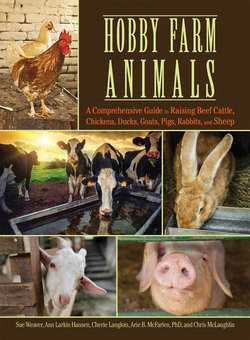Читать книгу Hobby Farm Animals - Chris McLaughlin - Страница 31
На сайте Литреса книга снята с продажи.
Weaning Calves
ОглавлениеWeaning involves separating the cows from the calves so the calves can’t nurse anymore and the cows’ udders dry up, giving them a rest and a chance to regain a little weight before calving again. Weaning is the most stressful thing that ever happens to a calf, and it’s hard on the cows, too. Make it as gentle as possible.
The first rule is not to wean by loading the calves onto a truck and sending them off to the auction barn or feedlot. Although this method is still common, it inevitably results in a lot of sick, and a few dead, calves. Consequently, buyers have learned to pay less for “truck-weaned” calves.
With a small herd on a small farm, it’s generally impractical to separate cows and calves by enough distance that they won’t be able to hear each other bawling during weaning. And they will bawl. It may take as long as three days and nights of steady noise before they either get tired of it or get too hoarse to go on. There’s nothing much you can do about it.
The most practical method for the small operator, which also tends to minimize the noise, is called “fence line” weaning. This involves splitting the cows from the calves and then putting the calves back into their familiar pasture and the cows in an adjacent pasture. This at least gives them the comfort of seeing each other, even if the calves can’t nurse. If you do this, be aware that a single-wire electric fence will not keep the two groups apart. They need to be on either side of a sturdy, perimeter-type fence, and it doesn’t hurt to have an electric wire as reinforcement. You’ll also need to set up a separate water tank and a separate salt and mineral feeder for the calves. There will still be an amazing amount of noise, but the noise doesn’t seem to last as long with this method.
Alternatively, you can move the calves into a pen with plenty of hay and water and put the cows back on pasture. The calves may take a little longer to settle down than if they were in their familiar pasture, but they eventually will. If you use this approach, remember that calves should not go directly from pasture to hay. Instead, gradually introduce hay into their diet well before weaning to allow their digestive systems time to adjust. Weaning and a sudden change in diet at the same time are a recipe for illness.
Buyers prefer that calves be weaned for a minimum of three weeks before shipping, so plan accordingly. Heifers or steers that you’ll be keeping for your own herd need to be kept separate from their mothers for about three months, and heifers should be kept separate from the bull until they’re ready to be bred.
